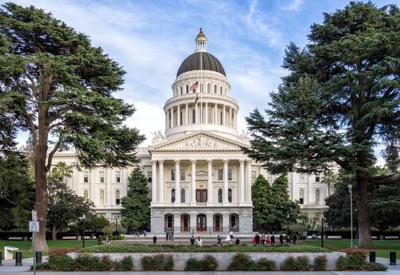
California State Capitol in Sacramento (Andre m / Wikimedia Commons)
This story was originally published by EdSource. Sign up for their daily newsletter.
Legislators returned to the statehouse this week for the four-week dash to decide which bills should be sent to Gov. Gavin Newsom for his signature. They’ll have until Aug. 29 to get an up or down vote in either the Senate or House appropriations committees and then until Sept. 12 to send legislation to Newsom’s desk.
Most bills that get this far stand a good chance of passage. But you may waste your dollars wagering on several contentious education bills still being negotiated. One would define antisemitism and set restrictions on its content in schools; two others, which may merge into one, would add oversight and tighten rules on preventing fraud in hybrid and online charter schools.
Here are summaries of a dozen K-12 and higher education bills worth watching.
Assembly Bill 715
Authors: Assemblymembers Rick Chavez Zbur, D-Los Angeles, Dawn Addis, D-San Luis Obispo
What will it do: The bill aims to reduce antisemitism and discrimination in schools by placing restrictions on curricula and providing training and resources to help teachers identify, prevent and track any instances of antisemitism in the classroom. It also establishes and ensures the appointment of an Office of the Antisemitism Prevention Coordinator, which would reside under the State Board of Education.
Why is it important: California has been home to increased rates of antisemitism, including on school grounds.
What’s next: The bill has passed through the Assembly and will next be heard by the Senate Education Committee.
Upshot: Much of the contention is over the definition of antisemitism, which opponents argue would suppress classroom discussion of Israel’s occupation of Gaza. Authors Zbur and Addis are optimistic about support for the bill and are confident it will pass, even though its hearing has been stalled, and the measure has been met with resistance from the California Teachers Association and teachers of ethnic studies.
— Mallika Seshadri
Assembly Bill 84, Senate Bill 414
Authors: Assemblymember Al Muratsuchi, D-Torrance; Sen. Angelique Ashby, D-Sacramento
What will it do: AB 84 would revise requirements for authorizing charter schools, especially non-classroom-based charters. SB 414, a response to AB 84 by charter advocates, would expand the training requirements and oversight of district auditors, expand the scope of audits on charter schools and school districts, require chartering authorities to report suspicion of financial crimes and require districts to vet educational enrichment vendors and perform background checks.
Why is it important: The bills follow several studies, big scandals and four years of moratoriums on non-classroom charters.
What’s next: Both bills are being revised simultaneously with the goal of merging the legislation into one bill.
Upshot: There are sticking points that are making it difficult for supporters of the bills to come to a consensus.
— Diana Lambert
Assembly Bill 49
Authors: Assemblymembers Al Muratsuchi, D-Torrance, Liz Ortega, D-Hayward, Celeste Rodriguez, D-Arleta, Sen. Lena Gonzalez, D-Long Beach
What will it do: The bill would prohibit schools from allowing immigration enforcement officers to enter a school campus or question a student unless they have a judicial warrant or court order. It would also prohibit schools from sharing information about a student, family or employee with immigration officials, unless the officials present a judicial warrant or court order.
Why is it important: All children living in the U.S. have a right to attend public schools, regardless of immigration status, as determined by the U.S. Supreme Court. The Trump administration ended a longstanding policy not to conduct immigration enforcement at schools or churches, raising concerns that some families will avoid school.
What’s next: The bill passed the Assembly and is currently in the Senate Appropriations Committee.
Upshot: The bill has had widespread support in both houses. It is likely to pass the Senate Appropriations Committee. It is estimated that it could cost hundreds of thousands to a few million dollars statewide for training and materials for districts.
— Zaidee Stavely
Senate Bill 98
Author: Sen. Sasha Renée Pérez, D-Pasadena
What will it do: The bill would require school districts, California State University, each California community college district and each Cal Grant qualifying institution of higher education, as well as request the University of California, to issue a notification to all students, faculty and other campus community members when the presence of federal immigration enforcement is confirmed on campus. These notifications must include the date, time and location of enforcement on campus, as well as a link to additional resources for students and campus community members.
Why is it important: While most schools provide guidelines to students, faculty and staff about how to engage with federal immigration enforcement officers if encountered on campus, there is no legal requirement to notify the community. With ongoing raids and continued fears of detention and deportation in immigrant communities, the bill aims to bolster a sense of security and maintain school campuses as “safe spaces” for students.
What’s next: The bill passed the Senate in June. The Senate Education Committee and the Assembly Higher Education Committee passed it in July, and it is currently under review by the Assembly Appropriations Committee with a hearing scheduled for Aug. 20.
Upshot: The bill is likely to pass the Assembly Appropriations Committee, as it is not expected to have major cost burdens. It is also likely to take immediate effect after Newsom signs it into law.
— Vani Sanganeria
Senate Bill 323
Author: Sen. Sasha Renée Pérez, D-Pasadena
What will it do: The bill would revise the California Dream Act application, clarifying that the form is open to any student who is eligible for state aid, regardless of their eligibility for federal financial aid.
Why is it important: The bill aims to address concerns that U.S. citizens from mixed-status families — such as students with undocumented parents or spouses — may not apply for federal student aid due to technical barriers and worries about data privacy. Heightened immigration enforcement has raised fears that the data students submit to access federal aid could be used to target undocumented family members. Though the California Dream Act application is open to mixed-status families, the California Student Aid Commission says the lack of a defined and uniform state policy has created uncertainty for students trying to understand their financial aid options.
What’s next: The bill awaits an Aug. 20 Assembly Appropriations Committee hearing.
Upshot: The bill is sponsored by the California Student Aid Commission, which administers financial aid programs for students attending school in California. It’s backed by dozens of other groups and has no registered opposition.
— Amy DiPierro
Assembly Bill 477
Authors: Assemblymembers Al Muratsuchi, D-Torrance, Dawn Addis, D-Morro Bay
What will it do: The bill would increase California teacher and classified school employee salaries by 50% over the next decade. It would also increase statewide school funding incrementally through the 2036-37 school year, allowing school districts to increase staff pay.
Why is it important: Teachers earn 23.5% less than other college graduates with comparable degrees, which keeps many graduates from entering the teaching profession, according to a legislative analysis of the bill.
What’s next: The bill passed the Assembly Education Committee unanimously on April 10, but was referred to the suspense file and could be heard next year.
Upshot: Getting the bill through the Assembly Appropriations Committee could be difficult, as it requires the state to fully fund the raises, which are expected to cost tens of billions of dollars between now and the 2036-37 fiscal year.
— Diana Lambert
Senate Bill 640
Author: Sen. Christopher Cabaldon, D-Napa
What will it do: The bill aims to make it easier for qualified California high school students to get admitted to California State University. Eligible high school students — those who have taken the required courses and maintained an appropriate grade point average — will receive mailers directly admitting them to participating CSU campuses.
Why is it important: Cabaldon’s reasoning is that there are lots of students who are academically qualified to attend CSU, but who don’t enroll because they have trouble navigating the admissions process. The measure follows a fall 2024 direct admission pilot program in Riverside County. Other provisions of the bill would build on an existing dual admission transfer pathways program at CSU.
What’s next: An appropriations hearing is scheduled for Aug. 20.
Upshot: The bill has no opponents on file and the backing of the Los Angeles Unified School District and other supporters.
— Amy DiPierro
Senate Bill 790
Author: Sen. Christopher Cabaldon, D-Napa
What will it do: The bill clears the way for the governor to sign onto an existing interstate agreement that sets standards for online college courses and degrees, but only under certain conditions. For example, the state would have to confirm that joining the agreement would not block California from enforcing its own consumer protection laws.
Why is it important: California is the only state that hasn’t joined the pact, which is called the State Authorization Reciprocity Agreement, or SARA. The bill’s author says joining SARA would make it easier for California colleges to enroll out-of-state students in online courses.
What’s next: The bill heads to an Assembly Appropriations Committee hearing on Aug. 20.
Upshot: The bill has attracted a mixture of concerned opposition and hearty endorsement. Opponents, including the California Federation of Teachers, say California is right to remain a holdout to SARA because the agreement doesn’t do enough to protect students from fraud and abuse. Meanwhile, supporters, such as the University of California, say the bill would level the playing field for California institutions seeking to offer online courses to out-of-state students.
— Amy DiPierro
Assembly Bill 1264
Author: Assemblymember Jesse Gabriel, D-Encino
What will it do: The bill would require the Office of Environmental Health Hazard Assessment to adopt regulations for ultra-processed foods (UPFs). It would require schools to begin phasing out harmful UPFs by Jan. 1, 2028. Beginning July 1, 2035, the bill would prohibit a school district, county superintendent of schools, or charter school from offering a “nutritionally adequate” breakfast or lunch that includes harmful ultra-processed foods or selling food or beverages with UPFs, except as part of a school fundraiser.
Why is it important: Nutrition experts point to the harmful effects of ultra-processed food, particularly among children. These effects include a higher risk of obesity, diabetes and heart disease, which disproportionately impact students from low-income communities.
What’s next: The bill has passed the Assembly and Senate policy committees, and in a fiscal hearing, all seven members voted to place the bill on the Senate Appropriations Committee suspense file due to fiscal impact.
Upshot: The bill is likely to pass if it clears the Senate Appropriations Committee, given its strong bipartisan support.
— Vani Sanganeria
Assembly Bill 1348
Author: Assemblymember Jasmeet Bains, D-Bakersfield
What will it do: School districts, county offices of education and charter schools can currently request average daily attendance (ADA) credit to make up for decreases in attendance reaching 10% of the student population that occur due to a specified list of reasons. This bill would add immigration enforcement actions to that list — which includes fires, floods, epidemics, earthquakes, and more — until June 30, 2029. When such a request for ADA credit is made, students must also be offered independent study.
Why is it important: Following this year’s sharp rise in immigration enforcement actions, plus the Trump administration ending a decades-long policy to avoid immigration enforcement in or near schools, there are heightened concerns that children are missing school to avoid encounters with immigration agents.
What’s next? The bill was most recently read by the Senate Appropriations Committee and referred to the suspense file.
— Betty Márquez Rosales
Assembly Bill 1400
Author: Assemblymember Esmeralda Soria, D-Merced
What will it do: The bill is the latest legislative attempt to allow California community colleges to offer bachelor’s degree programs in nursing. The bill would create a pilot program allowing 15 community colleges across the state to offer those programs.
Why is it important: California faces a nursing shortage. Supporters of the bill, which would give priority to colleges in areas underserved by nurses, say it would help address that shortage.
What’s next: The bill awaits a hearing in the Senate Appropriations Committee.
Upshot: If recent history is any indication, the bill will not become law. A similar bill, Senate Bill 895, was approved last year by lawmakers and would have allowed 10 colleges to offer nursing bachelor’s degrees, but Newsom vetoed it. That legislation was fiercely opposed by the state’s four-year universities, which are again opposing the newer bill.
— Michael Burke
Assembly Bill 1454
Authors: Assembly Speaker Robert Rivas, D-Salinas, and Assemblymembers Al Muratsuchi, D-Torrance, Blanca Rubio, D-Baldwin Park
What will it do: It would provide missing links to California’s comprehensive early literacy reforms, which are effective in other states. The bill would provide teachers with evidence-based resources and training in reading instruction, including phonics in kindergarten and first grade. The State Board of Education would select a new list of instructional materials tied to what’s commonly called the science of reading. Districts must select from the list or justify their choices. The state would update reading instruction in administrators’ credentialing programs.
Why is it important: The ability to read at grade level is a critical marker for success in school. Yet only 4 in 10 California third graders do so. The proficiency gap in reading between Black and Hispanic students compared with white and Asian students is among the nation’s widest.
Upshot: A similar bill last year died. This year, Rivas forged a deal, and Newsom followed with $200 million in a tight state budget to teach school trainers in the science of reading. Newsom will celebrate passage with a grand signing next month.
— John Fensterwald










(0) comments
Welcome to the discussion.
Log In
Keep it Clean. Please avoid obscene, vulgar, lewd, racist or sexually-oriented language.
PLEASE TURN OFF YOUR CAPS LOCK.
Don't Threaten. Threats of harming another person will not be tolerated.
Be Truthful. Don't knowingly lie about anyone or anything.
Be Nice. No racism, sexism or any sort of -ism that is degrading to another person.
Be Proactive. Use the 'Report' link on each comment to let us know of abusive posts.
Share with Us. We'd love to hear eyewitness accounts, the history behind an article.